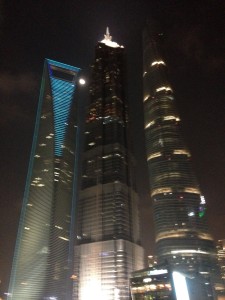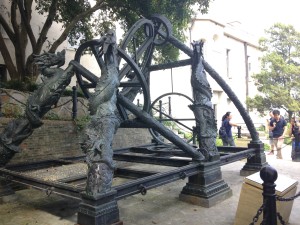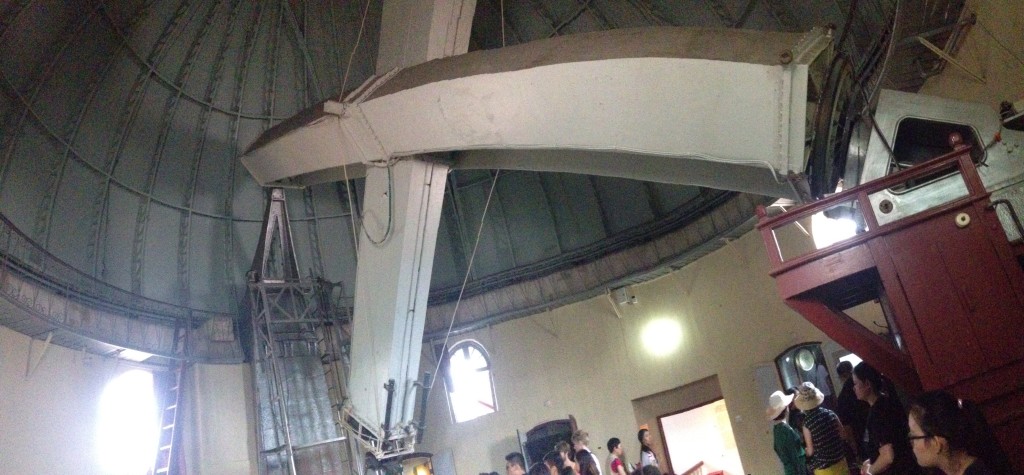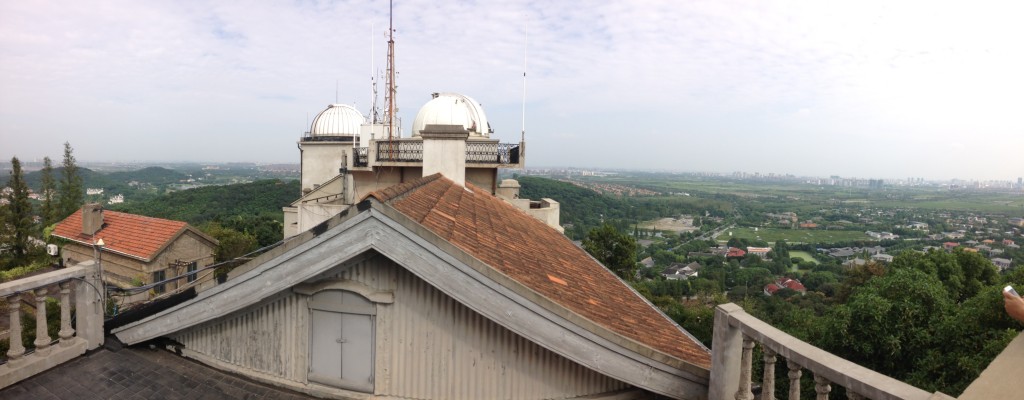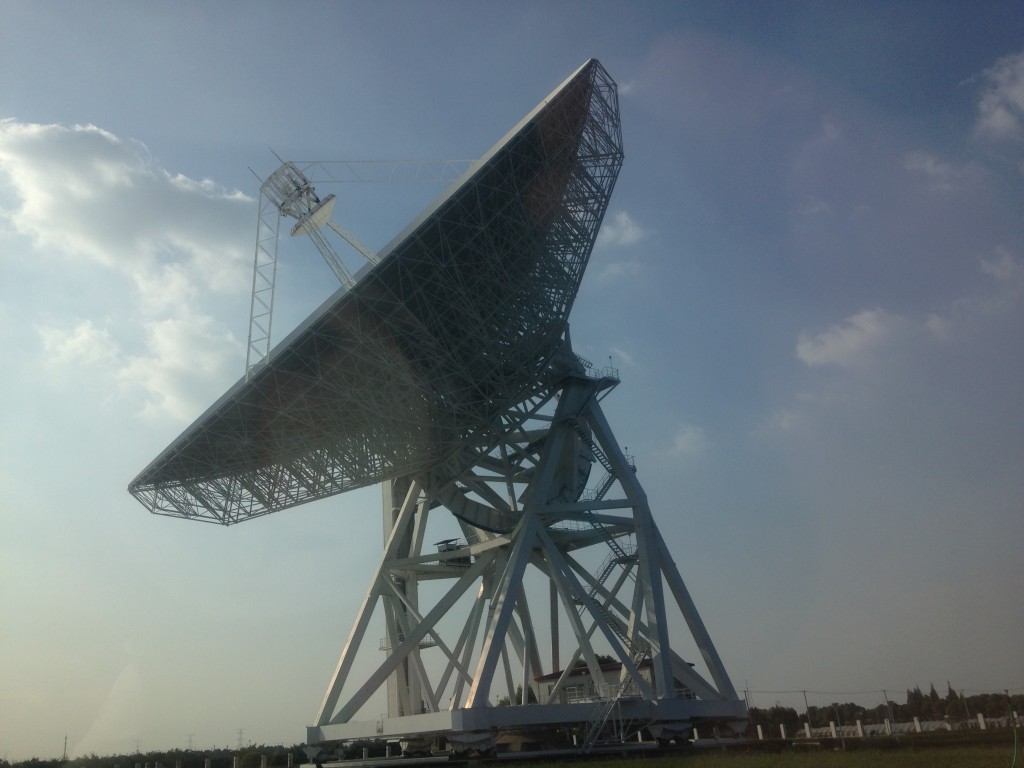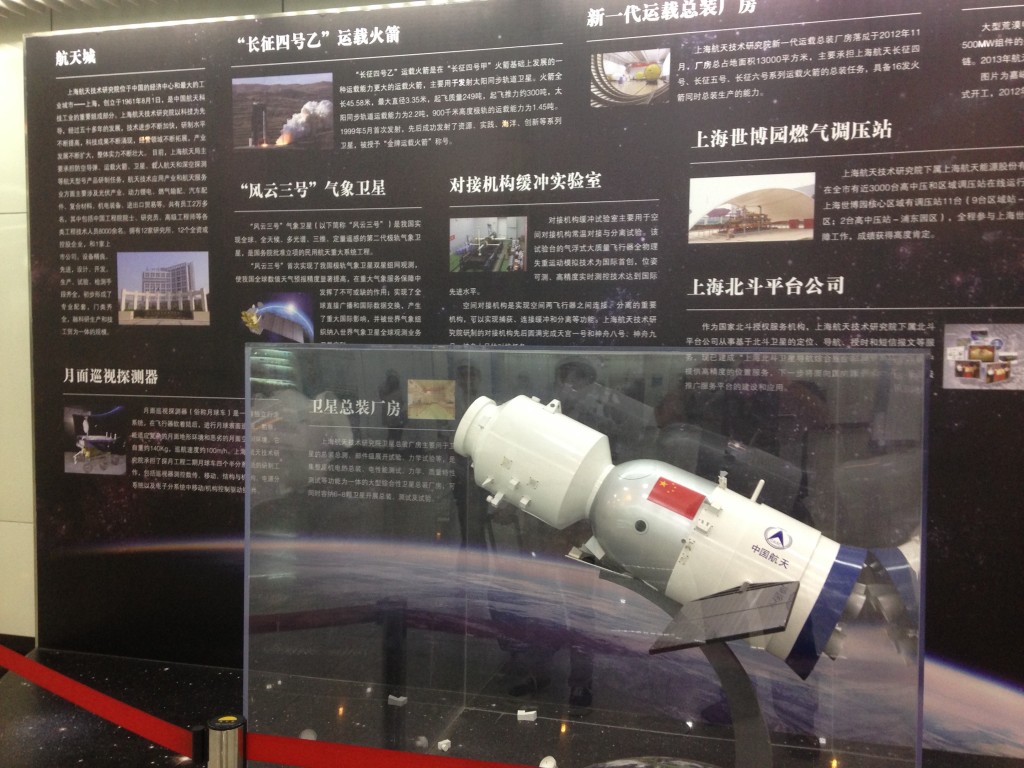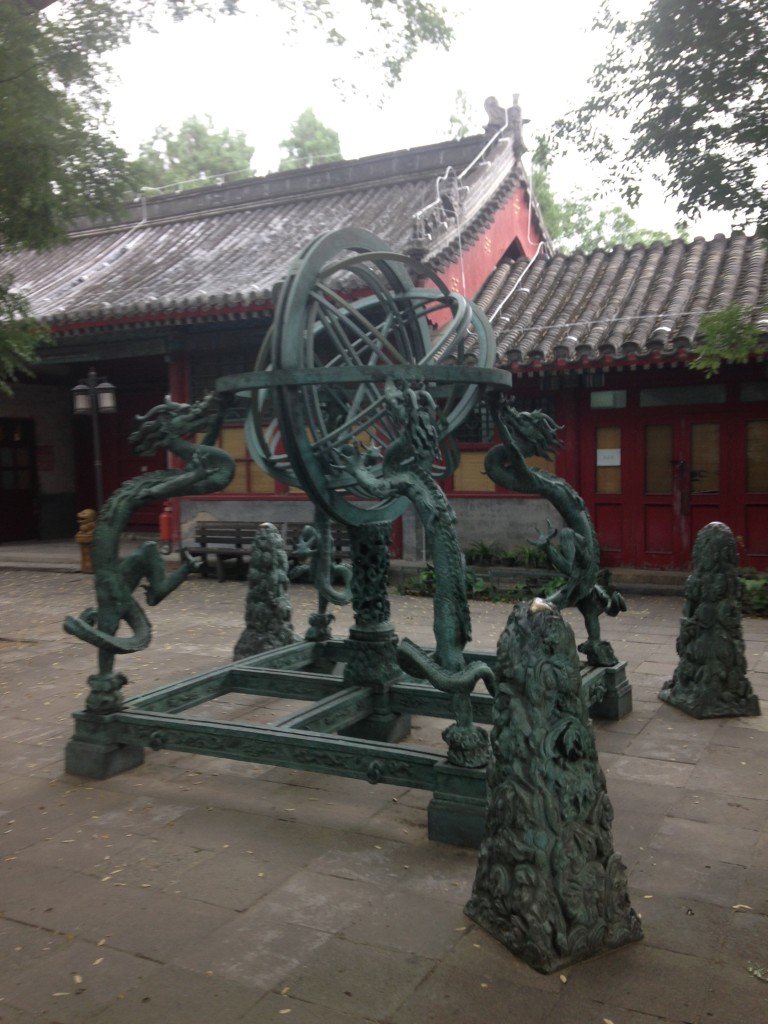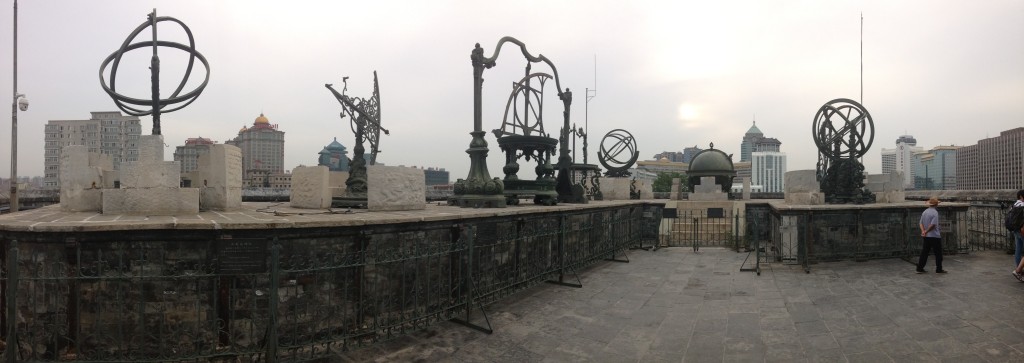The Ancient and Modern Chinese Universe
While I was a professor at Yale-NUS College in Singapore, I led an experiential learning “Week 7” course in China. The trip included bringing a team of 20 students through China to explore the nature of the Chinese universe – as it was considered in ancient times and now as China is becoming a dominant economic and technical power globally. The aspects of cosmology, culture, technology, and the science of astronomy were the particular focus of the trip. Below is a blog posting describing the trip and a syllabus for the trip, which was given to our Yale-NUS College students before we left for China. This trip was part of the Yale-NUS College “week 7” program, and I led the trip with the assistance of Yale-NUS CIPE staff member Charlotte Evans, who was fluent in Chinese and helped guide us through Beijing, Shanhai and Nanjing.
One resource that I developed with a student at Pomona College is a Suchow Planisphere viewer. The website allowed one to browse through the ancient Chinese constellations using the exact star chart developed in China during 1193 A.D. This chart, in the typical Chinese style, has the circumpolar region in the center of the image, with radiating lines indicating the lunar mansions or hsiu. These lunar mansions would provide a basis for observers to connect changes in the night sky to events in the Chinese empire and ultimately to diagnose what it means for the Emperor, the “Son of Heaven.” The connection between the sky and earth was dramatically embodied in the Forbidden City, which has a layout similar to the planisphere, with the Emperor’s quarters in the northernmost part of the compound, just as in the sky. The circumpolar stars, connected to the hsiu, provided a basis for diagnosing the sky, and each of these stars represented some aspect of the kingdom.
Our group used China’s amazing high-speed rail system. We were able to visit Beijing, Shanghai, and Nanjing in just over a week. Our trip explored the ancient and modern cosmology of China, which included visiting the Forbidden City, Temple of Heaven, ancient observatories such as the Beijing and Purple Mountain Observatories, and the Shanghai Sheshan Observatory, with the largest telescope in Asia – a 65-meter steerable radio telescope. China’s modern universe includes riding bullet trains, modern astrophysics research centers, and advanced political think tanks. While we visited Shanghai, we examined the skyscrapers in downtown Shanghai from a cosmological perspective and met students and faculty at NYU Shanghai.
Some of the highlights of the trip included our meeting with NYU Shanghai students, who eagerly connected with our Yale-NUS students from Singapore. We also enjoyed measuring skyscrapers in Shanghai with a theodolite app on ipads and a laser rangefinder. We were able to visit the Shesan Observatory, with its nearly 200-year-old tradition of astronomy begun by Jesuits, visit the Beijing Observatory and its 500-year-old instruments, and tour the Purple Mountain Observatory with its original bronze instruments from the 1400s. We also had a chance to see Asia’s largest telescope – the 65-meter Shanghai radio observatory.
During our visit, we joined a press conference for China’s new Dark Matter satellite, toured the science labs for the Purple Mountain Observatory, heard a talk about China’s geopolitics and linguistics from David Arase (a former colleague from Pomona, now at the JHU Nanjing center), and from Neil Kubler (Director of the JHU Center). It was wonderful exploring China with our amazing Yale-NUS students and enjoying dumplings, large hot pot dinners, and other Chinese food. We had an amazing evening at the Beijing Temple Hotel, where a Turrell exhibit allowed us to watch the sunset in a specially constructed room with a square portal viewing the sky.
A photo album from the trip is below!
The Ancient and Modern Chinese Universe: Itinerary and Syllabus for Week 7 Trip
Number of students: 18 – 20
Participating Faculty: Bryan Penprase
Schedule (Date of Departure/Return to Campus): 22 September – 1 October
IMPORTANT NOTE: This Week 7 departs on Tuesday, 22 September. Students will need to return early from vacation and should plan on having prepatory work done in advance of the trip. Additionally, this Week 7 may require a student co-pay (Financial aid and merit grants are available. Please do not let finances deter you from participating).
Readings:
David H. Kelley, and Eugene F. Milone, Exploring Ancient Skies – An Encyclopedic Survey of Archaeoastronomy, Springer, Inc., p. 9-42, p. 313-333.
Anne Birrell, Chinese Myths, British Museum Press, p. 7-50.
Bryan Penprase, The Power of Stars – How Celestial Observations have Shaped Civilization, Spring, Inc., p. 1-80, 118-123, 157-161, 205-218, 229-234, 289, 303.
Articles on James Turrell and the installation in Beijing
Guides to Purple Mountain Observatory http://english.pmo.cas.cn ; http://www.travelchinaguide.com/attraction/jiangsu/nanjing/zijinshan.htm
PDF Files of Readings:
Power_of_Stars_Chapters1_2.pdf
 –
– 
 Selection from Penprase, “Power of Stars.”
Selection from Penprase, “Power of Stars.” 

China, Korea, and Japan – Springer.pdf
 – Selection from Kelley and Milone, Exploring Ancient Skies – An Encyclopedic Survey of Archaeoastronomy, Springer, Inc.
– Selection from Kelley and Milone, Exploring Ancient Skies – An Encyclopedic Survey of Archaeoastronomy, Springer, Inc.
jesuit.astronomers.in.china.pdf
 – Account of Jesuit Astronomers, Matteo Ricci and the Beijing Observatory
– Account of Jesuit Astronomers, Matteo Ricci and the Beijing Observatory
thurston.ancient.astronomy.chinese.section.pdf
 – Selection from “Ancient Astronomy” by Thurston, on Chinese Astronomy.
– Selection from “Ancient Astronomy” by Thurston, on Chinese Astronomy.
Historical Supernovae Paper Scan from UCLA-1.pdf
 – Scan of paper on historical supernovae – giving examples of Chinese supernova observations.
– Scan of paper on historical supernovae – giving examples of Chinese supernova observations.
Pages from Selin.astronomy.across.cultures.pdf
 – Selection from book by Selin, “Astronomy Across Cultures,” on Ancient China.
– Selection from book by Selin, “Astronomy Across Cultures,” on Ancient China.
Partner Organisations:
Purple Mountain Observatory, Nanjing
Johns Hopkins Center, Nanjing
Temple Hotel, Beijing
NYU Shanghai
Shanghai Observatory
Summary:
Within modern China is a booming economy known for its rapidly expanding cities and economic base, bullet trains, emerging space program, and manufacturing prowess. This thriving economy and culture are built on the foundation of ancient traditions – and throughout modern China, are remnants of these ancient world views. Skyscrapers within downtown Shanghai contain astronomical elements such as alignments with cardinal directions and extreme moonrise points, the layout of city blocks and businesses is planned with an awareness of feng shui, and numerological factors determine the counts of floors in buildings and other elements. Nearby Shanghai are temples and ancient astronomical observatories such as the Purple Mountain Observatory in Nanjing, where Chinese astronomers have studied the heavens for centuries and charted the locations of supernovae, comets, and planets using sophisticated instruments designed in China. In Beijing, the Imperial City is aligned with the cardinal directions, with the northernmost sections reserved for the emperor, mirroring the ancient view of the celestial sphere, where the innermost stars near the north celestial pole were associated with important bureaus of the empire. Temples around Beijing were also used by the emperor in a seasonal cycle that mirrored the motions of the sun and stars, with summer and winter rituals performed to maintain the “Mandate of Heaven.”
In this Week 7 trip, we will visit Beijing, Shanghai, and Nanjing with site visits to the most important temples and ancient astronomical observatories. Visits include a mix of ancient and modern astronomical sites, temples, and research centers to give students a perspective of China’s ancient worldview and cosmology as it coexists with modern centers for astrophysics and space exploration. Some sections of the book “Power of Stars” by Bryan Penprase will be studied by the students, and the sites described in the book will be visited and explored by local guides.
Building upon the concepts of celestial alignments and harmony, the Chinese astronomical systems were developed to amazing levels of accuracy well beyond that obtained by Western or Islamic astronomy. Within the imperial astronomical bureaus are invaluable records that can be used by modern astrophysicists to locate supernovae and to track comets. Our visit to the Purple Mountain Observatory will explore the interplay between the ancient Chinese astronomical traditions and the development of modern astrophysics within China. The modern astronomical enterprise includes building giant telescopes in Chile and China and launching new spacecraft to explore the moon and planets. These efforts, like the ancient astronomical efforts, both are intended to advance the state of knowledge of the skies and to advance the Chinese state in its development of technology and global prominence. Within Nanjing we will also visit the Hopkins Nanjing Center, where we will meet with some of the leading faculty who are studying the advancing role of China in the world and its emerging leadership in economics and politics. Within Nanjing, the “Southern Capital” are other fascinating historical monuments such as the Ming Palace, the “Heavenly Kingdom History Museum” and nearby Suzhou with its fascinating gardens. We will explore many of these sites as we gain a deeper insight into China’s history and culture.
Products to be delivered by students on the trip
- Photographic journal of the trip, with GIS-enabled maps to pinpoint key sites, study their alignments and locations within the concepts of celestial harmony.
- Blog with student contributed pieces discussing the emerging new roles of China in foreign policy, modern science and commerce.
- Report on astronomical instruments and astronomically aligned buildings within China.
- Measurements of Temple compounds and other sites within China, providing new research on orientation, dimensions and alignments with horizon astronomical points
- Reflective writing on personal cosmology – before and after trip – and observations of the ancient and modern cosmology of China
Sites to visit:
Beijing: Arrive on Wednesday, September 23.
- Imperial City and nearby temples – tour with an eye toward cosmic symbolism
- Tsinghua University, Beijing University – discussions with modern astrophysics and space science researchers
- Zhihua Temple
- Ditan Park
- Temple of Heaven
- Altar of the Moon
- Altar of the Sun
- Temple of Heaven Park and Dongcheng South
- Round Altar
- Summer Palace
- Temple hotel – lodging for Beijing, and also contains Turrell installation, art museum and a restored temple
Shanghai: September 26 or September 27
- Downtown tour with an eye toward “archaeastronomy of skyscrapers”
- Building tour of Shanghai world financial center, with moon gate
- Visit to NYU Shanghai – meeting with students and faculty
- Possible Visit to Shanghai Observatory
Nanjing: September 28, 29, 30
- Purple Mountain Observatory – both for modern astrophysics and ancient astronomy
- Ming Xiaoling Tomb
- Linggu Temple Scenic Area
- Johns Hopkins Center
- Nanjing Museum
- Ming Palace Ruins
- Imperial Examinations History Museum
- Taiping Heavenly Kingdom History Museum
- Memorial Hall of Nanjing Massacre
- Possible day trip to Suzhou to visit palace and gardens
Proposed itinerary
September 23 – morning (Links to an external site.) arrive in Beijing 11:15AM
transport to hotel; check-in. Afternoon at leisure to explore. Possible trip to Peking Observatory (a historic site) – need contact and guide!
September 24 – (morning) Forbidden City tour – need local guide + expert here!
September 24 (Links to an external site.) – (afternoon) Temple of Heaven/Ditan Park/Temple Hotel; sunset viewing of Turrell’s skyspace at Temple Hotel; have contact and costs for this amazing sensory experience
September 25 (Links to an external site.) – morning train to Shanghai (5 hours); arrive around 1:30PM. lunch near NYU Shanghai campus, meet with NYU Shanghai students + afternoon talk with professors from NYU Shanghai; possible joint dinner with professors & students at NYU Shanghai
September 26 (Links to an external site.) – ; morning walking tour of historic Shanghai Former French Concession, visit to Shanghai Science and Technology Museum; afternoon tour around Shanghai World Financial Center; possible evening trip to Sheshan Observatory (will check my contacts) or evening visit to Pearl Tower
September 27 (Links to an external site.) – morning at leisure to explore; afternoon train to Nanjing. Ming Palace ruins in afternoon
September 28 (Links to an external site.) – JHU Center – exact events to be arranged with David Arase, who can possibly lodge us, and arrange meetings with students and faculty to discuss China’s global presence and foreign policy; FULL MOON
September 29 (Links to an external site.) – Purple Mountain Observatory (Mid-Autumn Festival activities!) – I have contact with good friend of Director; hoping for VIP tour
September 30 (Links to an external site.) – depart Nanjing 14:10 – arrive Singapore after midnight (Oct. 1)


